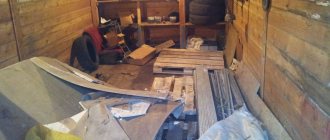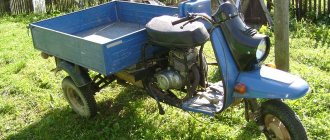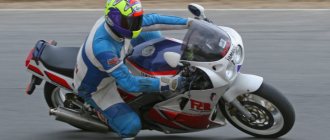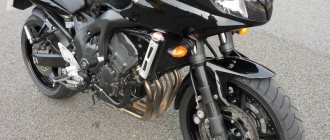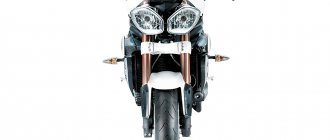| Yamaha FZ8N (2010-2015) | Yamaha FZ8S (FZ8 Fazer) 2010-2015 |
Yamaha FZ8 road motorcycle series
appeared in 2010 (model year - 2011) and replaced the Yamaha FZ6. The model was initially aimed at the markets of North America, Europe, Australia and New Zealand, but after 2013, the Yamaha FZ8 left the North American market, giving way to the Yamaha FZ-09 (MT-09).
The Yamaha FZ8 was based on the frame, engine and swingarm from the flagship model Yamaha FZ-1. The engine volume was reduced to 779 cc, a lightweight crankshaft, smaller valves and different camshafts were installed. As a result, the Yamaha FZ8 engine began to produce 106 hp. power and 82 Nm of torque. The engine pulls confidently at low and medium speeds, and produces maximum performance at 8000-10000 rpm.
Compared to the previous version (Yamaha FZ6), the new Yamaha FZ8 model received a more modern appearance, sportier suspension in the form of an inverted fork (adjustable since 2013) and a rear monoshock absorber, as well as more powerful 4-piston brakes on 310 discs mm. The fuel tank capacity has also changed, which is 17 liters, instead of 19 liters for the FZ6.
The Yamaha FZ8 model was produced until 2021, after which it was discontinued. The successor to the model, as mentioned above, was the Yamaha MT-09.
Main modifications of Yamaha FZ8:
- Yamaha FZ8N / NA (FZ8 Naked)
- a regular naked version without a front fairing. - Yamaha FZ8S/SA (Fazer8)
- version with front fairing and ABS as standard.
Main competitors of Yamaha FZ8:
- Honda VFR800X Crossrunner
- Kawasaki Z800
- Suzuki GSR 750
Brief history of the model
- 2010-2011 - start of production and sales of Yamaha FZ8. This year's motorcycles are presented as 2011 models. This year's models come in blue, dark gray and white.
Model:
Yamaha FZ8-N (Naked) / FZ8-NA, Yamaha FZ8-S Fazer / FZ8-SA (all regions).
Model code:
FZ8NAB, FZ8NACB (North America), 42P2, 39P4, 1BD1, 42P1, 59P1, 39P1 (Europe).
- 2012 - the appearance of a limited edition of Yamaha FZ8 motorcycles in white and red colors in honor of the 50th anniversary of Yamaha Racing. The main colors of motorcycles are dark gray, light gray and white.
Model:
Yamaha FZ8-N (Naked) / FZ8-NA, Yamaha FZ8-S Fazer / FZ8-SA (all regions).
Model code:
FZ8NBG, FZ8NBCG (North America), 42P5, 39PC, 39PB, 39P6, 1BD2, 42P4, 59P2, 59P3, 39P9 (Europe).
- 2013 is the last year of sales in the North American market. The fork becomes adjustable. The primary colors are similar to the previous year, but without the white and red versions.
Model:
Yamaha FZ8-N (Naked) / FZ8-NA, Yamaha FZ8-S Fazer / FZ8-SA (all regions).
Model code:
FZ8NDC, FZ8ND (North America), 42PB, 39PP, 1BD6, 1BD4, 42PE, 42PA, 59P5, 59P6, 39PT, 39PL (Europe).
- 2014 - no significant changes. The FZ8 is no longer available in the North American market.
Model:
Yamaha FZ8-N (Naked) / FZ8-NA, Yamaha FZ8-S Fazer / FZ8-SA (Europe, Oceania).
Model code:
2SH4 (FZ8-N), 59P8 (FZ8-NA); 42PG (FZ8-S), 1BD8 (FZ8-SA)
- 2015 is the final year of production for the Yamaha FZ8.
Model:
Yamaha FZ8-N (Naked) / FZ8-NA, Yamaha FZ8-S Fazer / FZ8-SA (Europe, Oceania).
Model code:
2SH7 (FZ8-N), 59P9 (FZ8-NA); 42PN (FZ8-S), 1BDA (FZ8-SA)
001-MOTO_0610_012
Yamaha FZ8 (in plastic - Fazer 8), roadster, 2010, 779 cm³, 106 hp, 211 kg (filled), 420,000 rub.
Yamaha FZ8 (in plastic - Fazer 8), roadster, 2010, 779 cm³, 106 hp, 211 kg (filled), 420,000 rub.
Don't worry, 600 fans, Yamaha hasn't killed the 600 class in the road category. On the contrary, it expanded the range of roadsters, committing a sabotage... The fact is that the 600th “Phaser” sported an engine from the R6 sports bike, which left its high-speed imprint on the character of the motorcycle, and it was frankly difficult for beginners to cope with its sharp character. For a wider audience of novice drivers, the XJ6, also known as Diversion 6 (if dressed in plastic), is better suited. The engine is softer and the handling is not as sharp as the Fazer 600, and the price has been reduced this year. And the eight hundred is precisely aimed at more advanced riders, but those who are either a little underdeveloped in terms of experience or solvency, or deliberately do not want to get on the “liter”. The FZ8 aims to take the lead in the mid-size roadster class from the Kawasaki Z750 (until now, only the Triumph Street Triple could timidly lay claim to competition with the Cava). Yes, the naked Yamaha is 900 euros more expensive, but it is also more modern than the Z750, which, by and large, has not changed since 2004. Well, since we’re talking about money, let’s note that the semi-fairing for the “naked” FZ8 (we’re talking about Fazer 8) will cost 500 euros. The price of retrofitting a motorcycle with an ABS system is the same.
Specifications
Yamaha FZ8 Specifications:
| Model | Yamaha FZ8 |
| Motorcycle type | naked |
| Year of issue | 2010-2015 |
| Frame | aluminum |
| engine's type | 4-cylinder, 4-stroke, in-line |
| Working volume | 779 cm³ |
| Bore/Stroke | 68.0 x 53.6 mm |
| Compression ratio | 12,0:1 |
| Cooling | liquid |
| Number of valves per cylinder | DOHC, 4 valves per cylinder |
| Fuel supply system | electronic fuel injection |
| Ignition type | transistor (TCI) |
| Maximum power | 106.2 hp (78.1 kW) at 10,000 rpm |
| Maximum torque | 82.0 Nm (8.4 kgm) at 8000 rpm |
| Clutch | Multi-disc in oil bath, cable drive |
| Transmission | 6-speed |
| type of drive | chain |
| Front tire size | 120/70ZR 17M/C (58W) |
| Rear tire size | 180/55ZR 17M/C (73W) |
| Front brakes | 2 discs, 310 mm, 4-piston calipers (NA, SA - ABS) |
| Rear brakes | 1 disc, 267 mm, 1-piston caliper (NA, SA - ABS) |
| Front suspension | 43 mm inverted fork (adjustable preload - since 2013), stroke - 130 mm |
| Rear suspension | Pendulum with monoshock absorber (preload adjustment), stroke - 130 mm |
| Overall dimensions (LxWxH) | 2140 x 770 x 1225 mm - Yamaha FZ8-S 2140 x 770 x 1065 mm - Yamaha FZ8-N |
| Seat height | 815 mm |
| Minimum ground clearance (clearance) | 140 mm |
| Wheelbase | 1460 mm |
| Gas tank capacity | 17.0 l (including reserve - 3.4 l) |
| Maximum speed | 221 km/h[1] |
| Acceleration 0-100 km/h (0-60 mph) | 3.51 sec[2] |
| Motorcycle weight (curb) | 212 kg / 217 kg (ABS) - FZ8-N 215 kg / 220 kg (ABS) - FZ8-S |
005-MOTO_0610_015
...and Fazer is in FZ.
...and Fazer is in FZ.
A couple of kilometers on the roads was enough for me to understand that Yamaha engineers hit the bull's eye with the engine tuning - the engine follows the throttle so smoothly, but at the same time quickly and confidently. Moreover, confident and even traction starts from 1100 rpm, that is, practically from idle. The engine does not stall or jerk, does not rattle from detonation and does not struggle from being “under-rotated”. It just pulls, and pulls great: the nature of the engine allows you to confidently accelerate in sixth gear from 50 km/h. No dips, no sudden pick-ups until the cutoff, which occurs at 13,000 rpm. It’s just a soft and smooth kick as soon as the tachometer needle crosses the 7000 rpm mark. The box clicks easily and clearly, without clanging or roaring.
So I can confidently call the FZ8 the ideal motorcycle for both beginners and veterans - it is so friendly and easy to ride. The throttle handle can be used to control not only any speed of acceleration, but also deceleration - by closing the throttle, it is possible to very accurately dose the braking torque. In general, it’s an ideal option for the city. Having got out of Marseille, on the mountain serpentines I became inspired by the handling of the 800. Although the chassis geometry here is the same as on the “liter”, the kinematics are clearly different - the motorcycle steers literally with the power of thought, shifting from step to step. Well, those who drive not only through traffic jams in megacities should take a closer look at the dressed-up Fazer, which has replaced the angular avant-garde headlight with a semi-fairing with Yamaha’s signature squinting headlights. Inside the fairing there was a digital speedometer, which, as soon as I looked at the scenery a little, already showed 200 km/h, and the tachometer needle hovered at 9200 rpm - three-quarters of the way to the red zone. Here I was pleasantly surprised by the ergonomics, which are clearly in harmony with aerodynamics. Sitting upright, I was in a cocoon between the rushing air currents, and the soul was not blown out of my chest, and there was not even a hint of a helmet coming loose. If you want to relax, slow down to a hundred and get high, immersing yourself in Zen.
Reviews
Yamaha FZ8 reviews:
Expand Collapse
I drove the FZ8 - I didn’t like it at all, at all. The motor seems to be electric, no pickup, no character. And the very feeling of the motorcycle, how can I explain it - as if it was all assembled from different parts, individual parts are not bad, but there is no whole motorcycle (this is not about frame wobbling or lack of rigidity, everything is fine with that, this is precisely the feeling from motorcycle as a whole).
I think that the FZ6 was much more interesting, even at the same price I would have taken it. Well, the modern Diversion, by the way, is okay, the XJ6 which, and even for a beginner, is more suitable. This is if we talk about the Yamaha line.
I recently purchased this model. Impressive! 4-cylinder engine 779 cm3. It showed itself quite as expected: of course, there can be no talk of high speeds here, but in all other respects it is in no way inferior to the 1000 cc. The price is great so you don't have to overpay for unnecessary power. Beautiful Japanese, without any frills, everything is clear and thought out. I was disappointed that the suspension is not adjustable; this is, of course, inconvenient. Well, I would like the acceleration to be faster, although many argue that it is the same as in the 1000. Overall, it’s a good model, there are no particular disadvantages. The increased power is felt immediately.
I rode this one and really liked it! Powerful, cool car. And, most importantly, reliable. They really didn't skimp on the build quality. The rear swingarm and front suspension are all made of aluminum. Just like in 1000, the design is like two peas in a pod. But the developers didn’t think about adjusting the suspension. It is simply not provided for on a motorcycle. As for the rear shock absorber, that’s also a mistake. In this model, it can only be adjusted by pressing. Good pickup at the level, acceleration is smooth, not at all the same as in 1000. This is clearly a plus. The design is simply top notch! It's immediately obvious that this is a thing. Moreover, it looks quite expensive, you can’t even tell that it was purchased for that price. I like the weight. In the city it is simply an irreplaceable thing!
003-MOTO_0610_015
Usually, when searching for compromises, there are sacrifices.
But here, as it turned out, there are no compromises, but rather harmonious combinations. And this, I must say, is not the first time for the FZ/Fazer family. Usually, when searching for compromises, there are sacrifices. But here, as it turned out, there are no compromises, but rather harmonious combinations. And this, I must say, is not the first time for the FZ/Fazer family.
When designing this 800, the engineers used as a base the same engine that powers the FZ1 (the latest 20-valve engine that came from the 2006 R1 sportbike), but “scaled it up” a little. The volume of 800 cm3 was not chosen by chance - it is rare that an engine of a smaller volume pulls passably at low and medium speeds, while having a “juicy” top. Thanks to the dimensions of 68x53.6 mm, the designers lowered the cylinder block (relative to the crankcase) by 9 mm, which brought the center of gravity of the entire power plant a little closer to the ground. The stiffness of the springs in the clutch was reduced, which means the squeezing force, and they “played around” with the gear ratios of the box a little - bringing them closer together to improve dynamics. The engineers also abandoned the 5-valve timing scheme in favor of the classic 4-valve, and the profile of the camshaft cams was made less “greyhound”.
007-MOTO_0610_016
The 800's engine is only 8 horses more powerful than last year's 600.
Squeezing out an additional 200cc is a juicy moment that spreads across the entire rev range. The 800's engine is only 8 horses more powerful than last year's 600. Squeezing out an additional 200cc is a juicy moment that spreads across the entire rev range.
Returning to the winding mountain road, I carefully studied the operation of the suspension and brakes. If the suspension seemed a little soft after the road euphoria, then the brakes can be given a solid five. Then add a plus by installing reinforced brake hoses and call them ideal. But that’s later, when the Fazer settles in my garage. And here’s the summary: Yamaha released not an update of the six hundred and not a smaller copy of the “liter”. Fazer 8 is basically a new machine. Very balanced, functional and friendly. Two-faced, but not like Janus - both faces, covered and naked, are beautiful and multifaceted in their own way. It’s a pleasant trend, I must say. So, next year we’ll be waiting for two incarnations of the eight hundredth “Diversion”?
Yamaha Fazer 800 at long range: advantages and disadvantages
We all know about cars, but what is the world of motorcycles like? How does he live? Sergei Fonton (senior) talks about this in the “Bikepost” program on Vesti FM radio. On the first day I traveled from Moscow to Rostov-on-Don. 1100 kilometers is just a good size for a day's trek. If you leave early, you can reach the village of Kushchevskaya - this is a hundred kilometers further. The place is notorious for the gang murder of a farmer's family. It is quite safe for travelers here. This primitive hotel is located right on the Rostov-Krasnodar highway. I arrived in the evening, fell asleep, sat down in the morning and left. All hotels - small and large - have guarded parking lots. So on this route you don’t even have to take off your panniers. By the way, if possible, do not install panniers at all, especially on high-speed motorcycles. From an aerodynamic point of view, this is a large anchor. I was just traveling with a trunk. On high-speed sections I refueled every 160 kilometers. It turns out 8.5 liters per hundred. A lot of.
Pros and cons of the Yamaha Fazer 800 on a long journey. I'll start with the good. The motorcycle is fast, and 180-200 can be quite a working speed. Excellent brakes. ABS works well. Free boarding. 106 horsepower, high-speed engine, 6 gears provide first-class dynamics. What is especially important for overtaking, acceleration is good even at speeds over 100. Cars often go 130-140. On the Fazer you need a very short distance to overtake. Dynamics is a valuable quality for safety. I give it a big plus. With enlarged glass - decent wind protection. The flow occurs at the top of the helmet. Quite comfortable. Now the disadvantages. The seat is a bit hard - after two hours the fifth point becomes numb. By the end of the day my legs become uncomfortable. They are strongly bent at the knees. And the third factor is vibrations on the steering wheel and footpegs. In the city, with the irregular driving rhythm, I didn’t notice anything. When the engine runs for many hours at high speeds, the effects of vibration are obvious: the tips of the fingers and toes go numb.
A separate conversation about driving on rough roads. Like, for example, from Kerch to Feodosia. There are no holes with sharp edges, but rutting and swelling of the canvas is obvious. Washboard. The front and rear suspension travel of the FZ8 is the same - 130 millimeters. Not much in numbers, but the suspension works great. Over 4 thousand kilometers, breakdowns occurred only a few times. The wheel geometry was not affected in any way. Conclusion: The Yamaha FZ8 performs quite well on a long journey. An excellent motorcycle with a sporty bent. If you only have the money for one bike, Yamaha's Fazer 800 is a smart choice.
Why Fazer?
Perhaps it’s worth understanding what guided me when buying a motorcycle and what I chose from.
First, a little background:
My motorcycle life began with a scooter at the age of 8, and I first encountered the experience of driving a motorcycle at 16. During this time, I managed to get used to some of the key (in my opinion) features and advantages of a scooter, namely:
- availability of the required minimum luggage space
- decent wind protection (in the case of a maxiscooter)
- dirt protection
Then I took a top-end maxi-scooter as an ideal. At that time, I was considering the Yamaha T-Max 530 and BMW C600 Sport, as they could provide a high level of comfort while having good dynamics. In my heart I really wanted to drive a BMW, but due to the fact that the first batches of the C600 Sport and C650 GT had problems with the timing chain, and the official service employees on Sorge Street had truly crooked hands, it was the T-Max that was taken.
BMW C600 Sport
Yamaha T-Max 2012-2014
Alas, soon after purchasing the T-Max, the family ran into financial difficulties, and the device, which had not yet been tested, had to be handed over to a new owner. I was left without wheels for the entire season.
And already in 2015, I was able to allow myself to start looking for options. First of all, I rushed to Yamaha and BMW dealers to find out about the above-described models. Judging by the reviews of the owners of the C600 Sport, there were still problems, so I started looking for a new T-Max 2015 in the IronMax version, but here too I was met with failure: the crisis was gaining momentum, and therefore the Yamaha Motor company decided not to import it to Russia updated T-Maxes in 2015. Dealers had only pre-restyling versions, and at the same price as new ones. Obviously, buying a obviously outdated version would not be the best solution. Having no other acceptable options among scooters, I decided to look for a motorcycle.
Yamaha T-Max IronMax 2015
The three points described above, as well as advice from friends, helped me formulate approximate criteria for a future motorcycle:
- presence of fairing
- the opportunity to choose from the largest number of cases offered
- presence of ABS
- good dynamics and handling
- comfortable fit
In the end, I considered three motorcycles:
Yamaha MT-09 Tracer
The reason for the choice was the positive experience of riding its progenitor - the Yamaha MT-09. Curb weight - 210 kg. It is the newest among all three motorcycles, and also has all kinds of adjustments: seat height (845-860mm), handlebars, windshield position. The stock has a center stand. It has the most functional dashboard: here you can select the engine operating mode, a gear counter, and Traction Control. Unless you installed Flappy Bird.
In fact, I was initially inclined to take the Tracer because of its more modern and functional implementation, but I never managed to sit on it - in the lowest position of the seat I could only reach the asphalt with the toe of one foot, provided that my height is 183 cm .
Honda VFR800F
I was considering the VFR solely because of its extremely positive reputation among road motorcycle enthusiasts. To be honest, I didn’t spend much time on the “picture”, but there were reasons for this. And the first of them is appearance. I don't know what happened to the Honda designers, but the new VFR has such a disgusting appearance that you can only approach it from the side (my personal opinion). The second reason is excess plastic, which means that you can forget about the arcs. It also partially entails a third reason - weight. Curb weight - 239 kg. The huge T-Max weighs even less (221 kg)!
Yamaha FZ8-SA (Fazer8)
My friends from the motorcycle academy strongly recommended this motorcycle to me, although they recommended the 600, but they didn’t know then that it had been discontinued. Sitting behind the wheel of the Phaser for the first time, I realized: its landing position is standard (for me, again). The knees form an almost right angle, the back does not strain, and there is no need to reach for the steering wheel. Curb weight - 220 kg. The already classic “Yamaha squint” does not violate the phaser’s proven design over the years (there will be a few more words about this in the following posts): each individual line serves to create the image of a solid motorcycle, and this already inspired confidence in the phaser at my first acquaintance. Let's go over the previously described requirements: the fairing is in place, SHAD/Givi/Yamaha saddlebags and many others to choose from, there is a package with ABS, 106 horsepower - it should ride well, Deltabox frame and inverted fork, the fit is completely satisfactory. Conclusion: you have to take it!
A week after signing the contract, I was already taking it to the traffic police for registration.
But we’ll find out a little later whether my choice turned out to be correct in the end.
If the post was useful, please like it, it helps the page develop 
Make your choice responsibly!
Tags
- Yamaha
- Phaser
- Phaser8
- Fazer
- Fazer8
- FZ8
- FZ8-SA
- choice
- many letters
- long post
Motorcycle Yamaha FZ-8 2012 review
The description of the Yamaha FZ-8 2012 motorcycle is in the queue for publication of the article. Announcement: Today, for almost every new motorcycle that comes into being, marketers strive to carve out their own niche. This one is a road sport, this one is a recreational enduro. But what class should we include a motorcycle that has a little bit of everything? A good bike should have a reliable engine, comfortable ergonomics and simple controls...
Yamaha FZ-8 is a motorcycle that is rarely sold in Russia and is equipped with a fairly powerful 106.2 hp engine. Despite the fact that good models of motorcycles have a very respectable price, and the season for their use is relatively short, the motorcycle market is developing rapidly. And if you believe the words of dealers, then some models of recently released motorcycles are selling like hot cakes at the beginning of the season, and the models brought to Russia are clearly not enough to fully satisfy consumer demand.
A motorcycle has long ceased to be an alternative to a car, and the times when this equipment was bought only because there was not enough money for a full-fledged car are forgotten. Nowadays, two-wheelers can be called technological marvels in many cases, and their cost can be compared with that of prestigious cars.
Many people have started buying motorcycles for hobby purposes as riding or even collecting them has become a good pastime for many people. Many motorcycles, for example the Yamaha FZ-8, the technical characteristics of which make it possible to call the model a prestigious brand, are in demand among both beginners and experienced motorcyclists.
Motorcycles with an engine capacity of 779 cc. see, appeared as a result of long work of inventors who sought to create a model that was not inferior in characteristics to other versions of the motorcycle. In some cases, these models are not only not inferior, but also ahead of other motorcycles, as they have minimal fuel consumption and other excellent parameters.
Motorcycles with an engine capacity of more than 400 kb. cm, which includes the Yamaha FZ-8 - this category of motorcycles simply cannot claim the title of “motorcycle for a beginner.” On the contrary, this is already a serious technique that requires certain control of motorcycle equipment with a smaller engine capacity. Yes, she attracts more attention, she is the most beautiful, fast, interesting and there is a huge selection of models. But as power increases, the weight of the motorcycle inevitably increases. In this class you are unlikely to find motorcycles lighter than 180 kg, unless they are the latest motorcycle models.
Go to the entire range of Yamaha motorcycles, on this page you can find Yamaha FZ-8 motorcycles from other years of production and information about them
Chassis and brakes
The frame of this motorcycle is made of aluminum, which significantly reduces the weight. The rear brake is served by a single disc along with a single-piston caliper, while at the front there are already a pair of discs, and they are assisted by four-piston calipers.
The suspensions here are no worse than the brakes and are just as well-chosen. Both the rear swingarm monoshock variant and the front inverted fork have the same average travel of 130mm. This makes the bike quite maneuverable and especially suitable for urban conditions.
